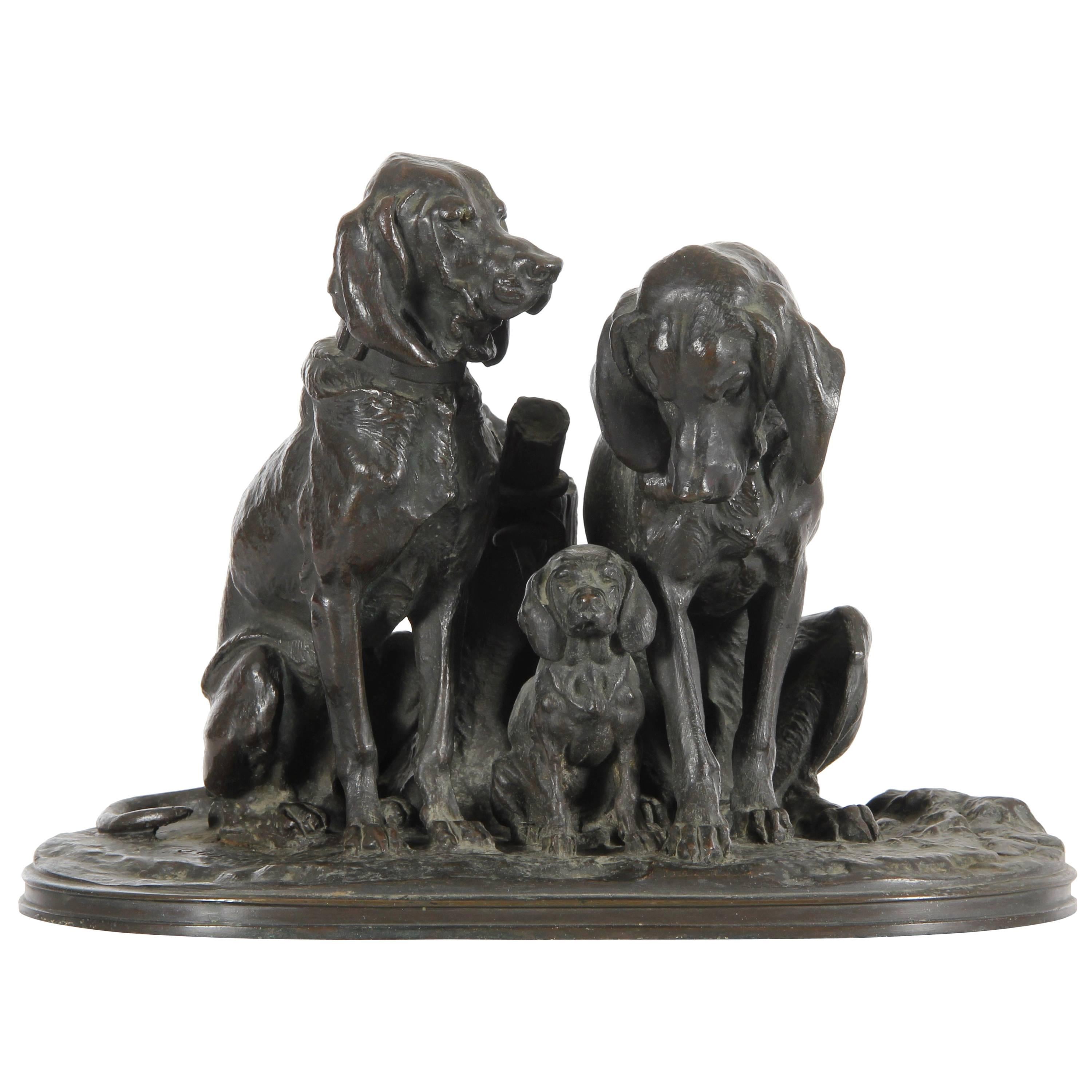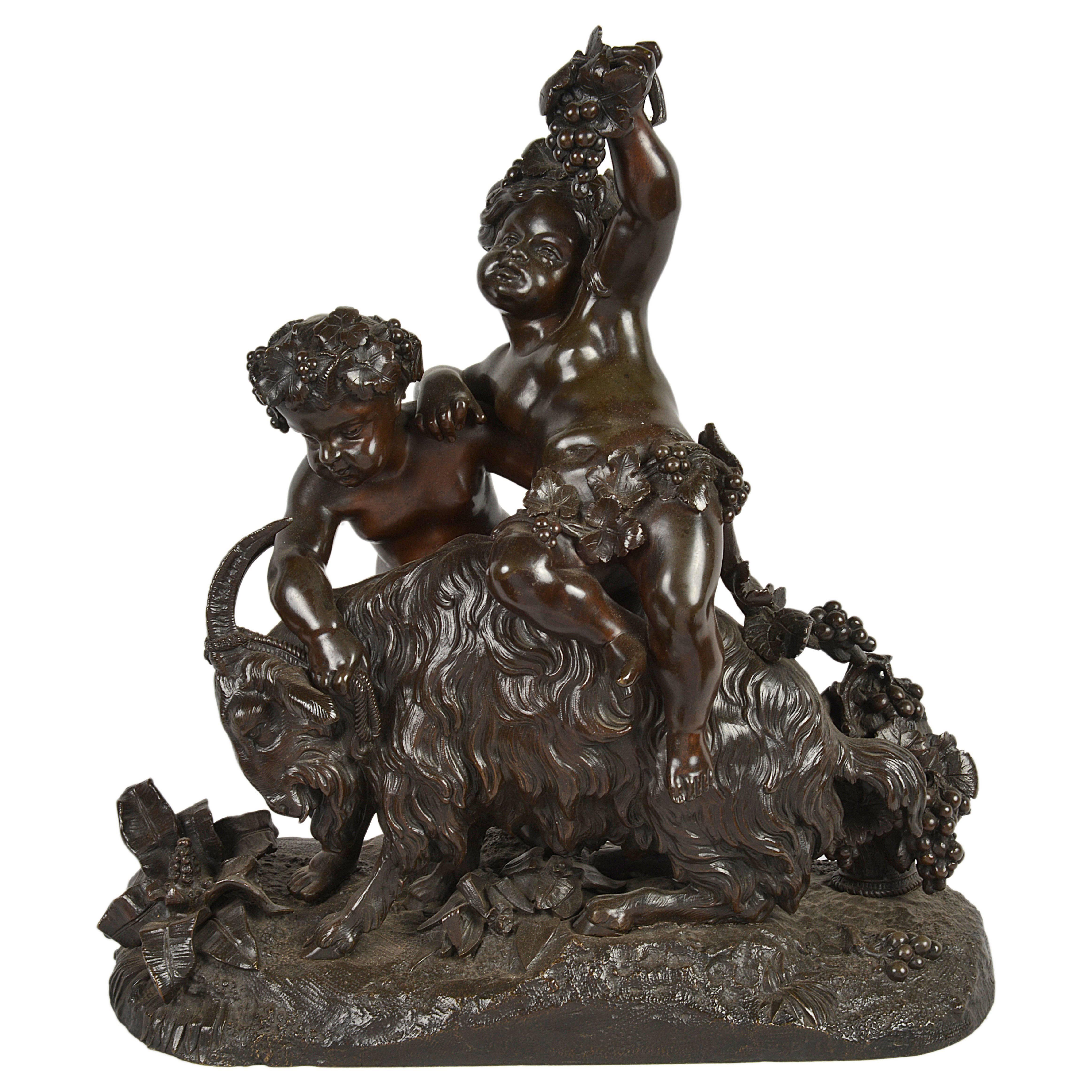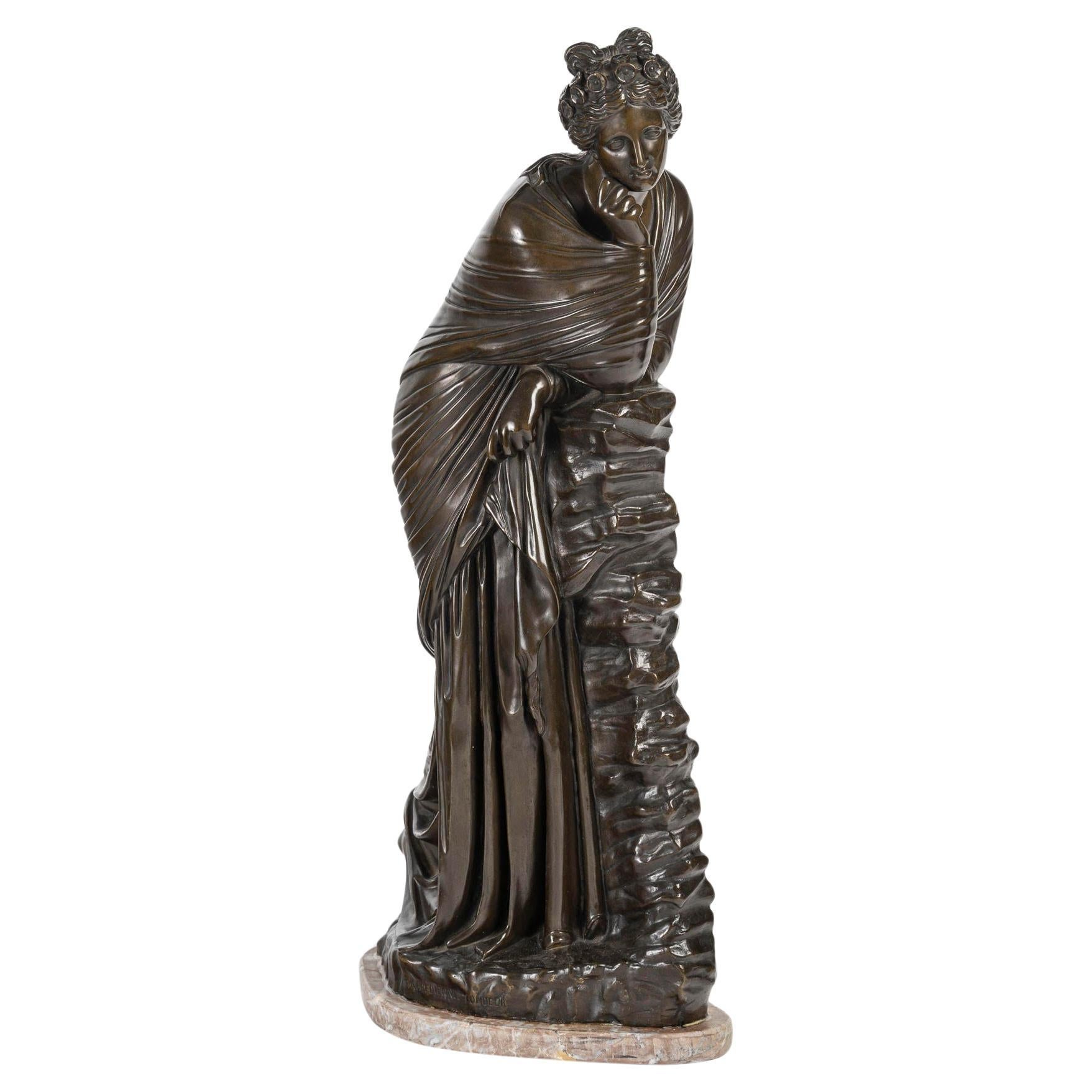Items Similar to Gilt Bronze Group, Sarpédon, Signed, Henri Peinte, Period, 19th Century
Want more images or videos?
Request additional images or videos from the seller
Gilt Bronze Group, Sarpédon, Signed, Henri Peinte, Period, 19th Century
About the Item
Superb gilded bronze group resting on a very pretty morello cherry marble, representing Sarpedon, Lycian hero who took part in the Trojan War against the Achaeans, bending his bow with a quiver and arrows at his feet.
Period: 19th century
circa: 1878
Dimensions: Height: 32cm x Width: 13cm x Depth: 11cm
Signed on the base "H. Peinte"
Sculptor of mythological subjects, Henri Peinte (1845-1912) was a pupil of Duret and Cavelier.
He exhibited for the first time at the Salon of 1877 and won a third class medal and the Prix du Salon, with a statue of Sarpedon.
It is the most famous work of Henri Peinte, noticed that same year by art critics Charles Tardieu, Henri Houssaye and Paul Mantz and produced for a public garden in Cambrai where it will be installed in 1878.
A Sarpédon's reduction in bronze earned him a Grand Prize at the Universal Exhibition of 1889, the year in which he was awarded the Legion of Honor.
Our sculpture is one of the reductions made the same year as that of the public garden in Cambrai and exhibited in 1889 in Paris.
The original plaster model is currently kept at the Musée des Beaux-Arts in Coulommiers. Several bronze editions are in the Museum of Fine Arts in Rouen.
- Creator:Henri Peinte (Sculptor)
- Dimensions:Height: 12.6 in (32 cm)Width: 5.12 in (13 cm)Depth: 4.34 in (11 cm)
- Materials and Techniques:
- Place of Origin:
- Period:
- Date of Manufacture:19th Century
- Condition:
- Seller Location:CRÉTEIL, FR
- Reference Number:1stDibs: LU7814232980252
About the Seller
4.0
Vetted Seller
These experienced sellers undergo a comprehensive evaluation by our team of in-house experts.
1stDibs seller since 2022
9 sales on 1stDibs
Typical response time: 1 to 2 days
- ShippingRetrieving quote...Ships From: CRÉTEIL, France
- Return PolicyA return for this item may be initiated within 14 days of delivery.
More From This SellerView All
- Pyrogen, Bronze Character on Cherry Marble Base, Period, 19th CenturyLocated in CRÉTEIL, FRPyrogen representing a figure in bronze. His face is jovial and he holds a tankard in his left hand. He is screwed on a griotte marble base. The scraper is between the shoes. Period: 19th century Dimensions : Height : 12cm - Diameter of the base : 8cm Pyrogenes are match holders, very common before the generalization of lighters, very useful because they can be portable. In the absence of electricity, they were necessary as well to light a stove as a paraffin lamp...Category
Antique 19th Century Figurative Sculptures
MaterialsMarble, Bronze
- Patinated Bronze, David Winner, Henri Plé, Company of Bronzes of Paris, 19thLocated in CRÉTEIL, FRMagnificent statuette in light brown and shaded brown patinated bronze. Old cast representing King David victorious over Goliath resting on a molded circular base. It is titled on a cartridge: "David winner" and annotated Salon des Beaux-Arts. It has a cast stamp on the back of the Société des Bronzes de Paris. This cast is very precise in detail, the facial features are well defined and its nuanced patina is original. Period: 19th century. circa: 1890-1900. Dimensions: Height: 43 cm x width: 15 cm. Signed hollow on the terrace: Henri Plé...Category
Antique 19th Century French Figurative Sculptures
MaterialsBronze
- Cavalier Terracotta Turquoise Glaze - Chinese Enamels - Period: 19th CenturyLocated in CRÉTEIL, FRA delightful statuette depicting a rider riding his mount, in terracotta with a turquoise, brown and white glaze known as three colours (sancai). The horse is standing on an oblong ...Category
Antique 19th Century Chinese Other Figurative Sculptures
MaterialsTerracotta
- Natural Stone Sculpture - Sodalite - China - Late 19th Century PeriodLocated in CRÉTEIL, FRA very fine piece of natural stone, Sodalite, made in China. Finely chiselled, this large statue depicts a scene of life in which several ancient symbols stand side by side, such as the Phoenix, swallows, a horse, earthly abundance with its luxuriant vegetation, fruit, but also food from the ocean and its generous fish, a man, a woman and a child. First discovered in Greenland in 1806, Sodalite was analysed by a Scottish chemist 5 years later (1811), Mr Thomas Thomson. Several long years went by without it achieving any real success. It was not until 1891 that the stone was recognised as an ornamental stone. It was during a diplomatic trip to Canada in 1901 that Mary de Teck (wife of King George V) discovered Sodalite and fell under the spell of this natural stone. The princess ordered a large quantity of Sodalite to decorate her London flats. Sodalite quickly became fashionable. Period: Late 19th century - Napoleon III Dimensions: Total height with base: 92cm x Width: 31.5cm x Depth: 27cm Dimensions of wooden base: Height: 7cm x Length: 25cm x Width: 23cm But what do these symbols mean? The phoenix, a mythological bird, symbolises purification and rebirth, as it is said to rise from its own ashes. This magnificent bird is also synonymous with good fortune, opportunity and luck in Asian cultures. In feng shui, the phoenix is also one of the four celestial animals (sometimes also known as the red bird or red raven). The red phoenix...Category
Antique 19th Century Chinese Other Abstract Sculptures
MaterialsStone
- Bronze Male Bust, Signed A.Nicolle, 20th CenturyLocated in CRÉTEIL, FRVery nice bronze bust of a man representing Mr. Michel Jouvet (neurobiologist) made by Madame Anne. NICOLLE. Period: XXth Circa: 1994 Measures: H: 13.5cm (without the base) H: 1...Category
20th Century Busts
MaterialsBronze
- Pair of Gilt Bronze Candlesticks Attributed to F.Barbedienne Period 19th CenturyBy Ferdinand BarbedienneLocated in CRÉTEIL, FRLovely pair of gilt bronze candlesticks, attributed to Ferdinand Barbedienne. The tripod base in the shape of lions' paws is surmounted by a collar formed of aquatic vegetation where a salamander wanders. On the fluted, elegant and straight was another salamander hastens to find its congener. The shoulder supporting the four light arms in the shape of an oil lamp is highlighted by three African elephant heads. The sockets are original and removable. A magnificent fantastic creature, guardian of this royal and symbolic fauna, half man, half animal, serving as an extinguisher, comes to magnify the whole of this sublime achievement of quality in all respects. Period: Late 19th century Dimensions: Total height: 55.5cm x width: 16cm The elephant is often seen as a symbol of strength and power. Being a large and magnificent animal, it is quite logically considered a powerful and majestic creature. His way of life, dependent on the herd, is at the origin of deep relational bonds based on loyalty, which develop the power and the will to defend others. The salamander had an amazing reputation for walking through flames. This alleged power has earned him, among other things, to be a royal symbol. With this exceptional power, the salamander was chosen by one of our most flamboyant kings, François 1er...Category
Antique 19th Century Napoleon III Candlesticks
MaterialsBronze
You May Also Like
- 19th Century, Henri Alfred Jacquemart Bronze Dog Group SculptureBy Henri Alfred Marie JacquemartLocated in Courbevoie, FRAlfred Jacquemart (French, 1824-1896) bronze figural group of three hunting pointers dogs, including a puppy, seated by a tree stump, on a naturalistic base of grass, leaves and roots. Original brown patina. Signed A Jacquemart...Category
Antique 19th Century Animal Sculptures
MaterialsBronze
- 19th Century Henri Picard Children Gilt Bronze SculptureBy Henri PicardLocated in CABA, ARHenri Picard, a master of artistic metalwork during the opulent Second Empire period in France, remains a figure of enduring fascination and admiration in the realms of antique art a...Category
Antique Late 19th Century French Napoleon III Figurative Sculptures
MaterialsBronze
- 19th Century Bronze Group After FalconetBy Étienne Maurice FalconetLocated in Paris, FRBronze group with brown patina featuring Cupids fighting over a heart after Etienne-Maurice Falconet (1716-1791). This work had a great success in the second half of the 19th century...Category
Antique 19th Century French Louis XVI Figurative Sculptures
MaterialsMarble, Bronze
- Classical 19th Century Bacchus Bronze GroupLocated in Brighton, SussexA very pleasing 19th century French Bacchus influenced bronze group, depicting two putti playing with a ram, garlands of vine leaves and grapes. Signed.Category
Antique 19th Century French Figurative Sculptures
MaterialsBronze
- Bronze Sculpture Signed Moreau, Napoleon III Period, 19th Century.By Auguste MoreauLocated in Saint-Ouen, FRBronze sculpture signed Moreau, Napoleon III period, 19th Century. Sculpture in patinated bronze signed Moreau, 19th century, Napoleon ...Category
Antique 19th Century French Napoleon III Figurative Sculptures
MaterialsBronze
- Bronze Sculpture, Signed F. Barbedienne, 19th Century, Napoleon III Period.By F. Barbedienne FoundryLocated in Saint-Ouen, FRBronze sculpture, signed F. Barbedienne, 19th century, Napoleon III period. Bronze sculpture, marble base, mechanical reproduction, signed F. Barbedienne, foundryman, pretty draped ...Category
Antique 19th Century French Napoleon III Figurative Sculptures
MaterialsMarble, Bronze
Recently Viewed
View AllMore Ways To Browse
Gilt Award
Gilt Plaster
Gilt Arrow
Medal War
Model Bend
Bow And Quiver
French Gilt Bronze Statue
Bronze Hero Sculpture
Bow Arrows Quiver
Trojan War
French Plaster Art Models
Mythological Statues
Marble And Gilt Statue
Plaster Medalion
Duret Bronze
Used Furniture Boulder
Wood Sculpture Stand 18th Century
Roman Marble Stand





